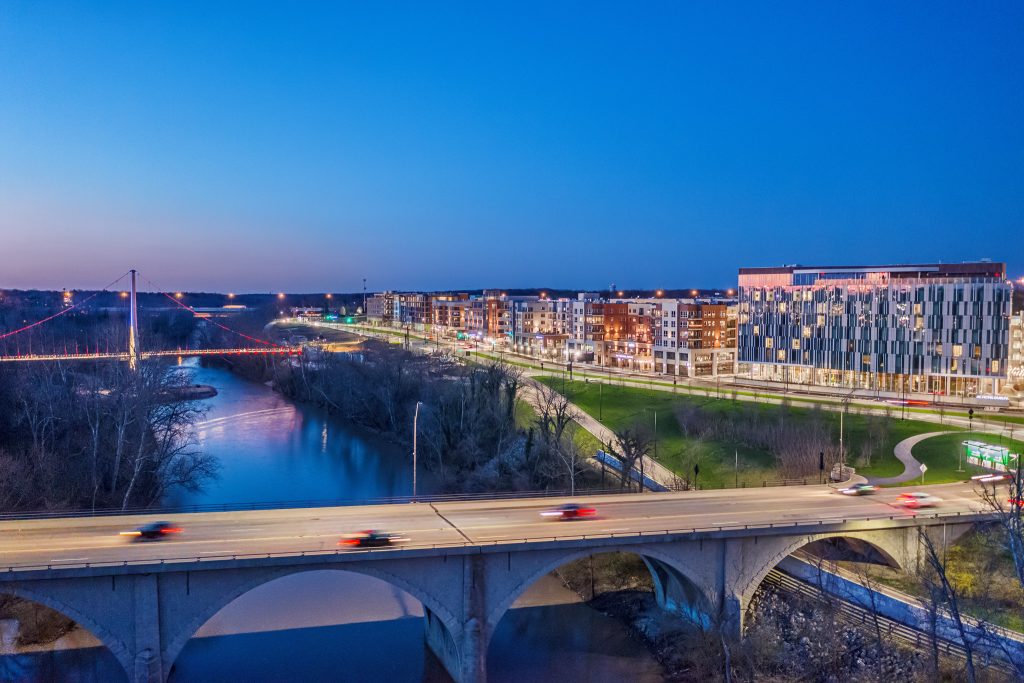The City of Dublin’s Bridge Street Vision, 10 Years Later
Rachel Ray, AICP
City of Dublin
 The Bridge Street District vision recently turned 10 years old – a significant milestone.
The Bridge Street District vision recently turned 10 years old – a significant milestone.
On October 25, 2010, Dublin City Council approved Resolution 50-10: Adopting the Vision Report and Implementation Strategy for the Bridge Street Corridor Plan. This action laid the foundation for a series transformational projects resulting in the thriving, and still-expanding, mixed-use Bridge Street District at the heart of our community.
As part of Dublin’s Planning Department in 2010, I was tasked with the project’s coordination alongside Goody Clancy, the consultant team hired to lead the effort. Coming out of the Great Recession, the opportunity to work on a plan this bold and exciting was a thrill, especially so early in my development career.
In recognition of this milestone, here are a few reflections on the legacy and impact of the Bridge Street Corridor Vision as a monumental planning and development success story.
- Key to Success: A Strong Communication & Education Campaign: More than a year before Council’s adoption of the vision, the City and consultant team hosted a speaker series and public meetings to engage the community in a dialogue about the issues underpinning the vision. This allowed us to craft the narrative and tell a compelling story long before the plan was released into the wild, and left to interpretation in a vacuum. With social media being what it is today, this principle has only increased in importance.
- Six Percent: Several key messages were consistently used to reinforce the purpose of the Bridge Street vision and manage the narrative surrounding the process. An example: concerns were raised throughout the process that the plan was an attempt to urbanize and densify Dublin, to the point it would no longer be recognizable as the suburban community that its citizens knew and loved. Our team regularly noted that the Bridge Street District accounts for only six percent of Dublin’s overall land area, and guaranteed that the mixed-use development contemplated in Bridge Street would not spill over, and in fact would amenitize and add value to the remaining 94 percent of the city.
- A “Cartoon,” Not a “Master Plan”: Another effective communication tool was the Illustrative Vision Planfor the Bridge Street District, which served the purpose of broadcasting that the City of Dublin was serious about its commitment to doing something beyond “business as usual” in Bridge Street. The Vision Plan was never intended to be a master plan – no one expected or intended the Bridge Street District to develop as drawn. Instead, it was a storytelling device that made a statement and visually conveyed a bold vision.
- Building Support Is a Ground Game: It’s true now, and was a key to success in 2010 and the years since: relationships matter. An enormous amount of time and energy went into engaging stakeholders, keeping them informed, and involving them in the vision formation. Thanks to this effort, we ended up with a wide range of champions for the Bridge Street vision that supported its adoption and helped communicate its purpose. Stakeholder engagement isn’t a novel concept in planning; this process was just a vivid illustration of how incredibly important it is. And if were easy, there would be fewer plans sitting on shelves collecting dust.
- Vision + Implementation Strategy + Resource Alignment = Results: The Bridge Street District vision owes its success to the overwhelming support of leadership City-wide. City Council’s adoption of the vision and implementation strategy informed budget commitments, work priorities, and coordination among nearly every City department. This, in turn, communicated to the development community the City’s serious commitment to implementing the vision, underscored by the significant investment in the foundational studies and policies that paved the way for the private development, public infrastructure investments, and public/private partnerships we’re enjoying now.
There is no question that the Bridge Street District vision and the planning activities leading up to and following its adoption have contributed to Dublin’s consistent recognition as one of the best places to live, and work, in the country – and 10 years later, not even a global pandemic has stood in the way of that project’s growth.
OEDA Congratulates Graduates of the 2025 Ohio Basic Economic Development Course
OEDA Congratulates Graduates of the 2025 Ohio Basic Economic Development Course DUBLIN, OH – The Ohio Economic Development Association (OEDA) proudly congratulates the more than 85 participants who successfully completed the 2025 Ohio Basic Economic Development Course...
OEDA Begins Strategic Planning Amid Record Growth + Program Expansion
FOR IMMEDIATE RELEASE RFP now open for OEDA’s next strategic plan; proposals due July 1, 2025 COLUMBUS, OH; Tuesday, June 3, 2025 — The Ohio Economic Development Association (OEDA) has released a Request for Proposals (RFP) to develop a new strategic plan, its first...
OEDA seeks host communities for its Annual Summit
For Immediate Release OEDA seeks host communities for its Annual Summit For the first time, location proposals sought for 400+ attendee conference COLUMBUS, OHIO – TUESDAY, NOVEMBER 12 – Today, the Ohio Economic Development Association (OEDA) announced that is...